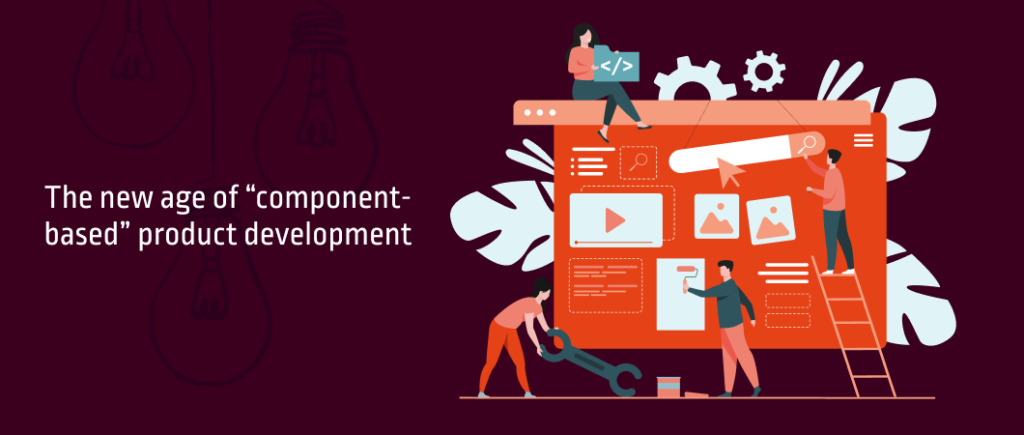Last updated on January 11th, 2024
During the early 2000s, concepts like commercial off-the-shelf (COTS) components and open-source software (OSS) were all the rage. The availability of ready-made third-party solutions meant that companies could, theoretically, access a wider range of tools without having to dive into the complexity of in-house proprietary software development.
Today, as we set the stage for Web 3.0 and address trends driven by the soaring startup scene, a new wave of component-based product development seems to be emerging. This one, though, is a bit out of the ordinary, and that’s due to the fact that businesses are being pushed to build faster, cheaper, more reliable, and ultra-versatile platforms to support a dynamic and growing user base.
Users are demanding convenience and accessibility over everything, which means that companies need a way to enhance the availability and usability of products and services. Speed is of the essence and “faster go-to-market” is the most prized ability.
Again, there are two ways to do this: custom-built applications and pre-packaged components, both of which are rife with opportunities and challenges. The latter, however, appears to be gaining tremendous traction.
But first, some background. There’s no denying that the pandemic has changed how companies do business. Most now value the characteristics of modern technology and seek ways to develop them to better serve their users.
According to Statista, more than 35% of the businesses had “partnerships” and “integrations” at the top of their list of development priorities in 2020. Such facts and figures do weave a narrative that points to the emergence of a component-based future for product development.
What is Driving this Change?
Numerous factors push companies to opt for the component-based approach instead of the makeshift alternatives. Still, perhaps the single most compelling element is that it’s easier to accommodate lightning-fast release cycles — a facility that has otherwise been only available to A-listers like Google, Apple, Meta, Microsoft, and the like.
Much like the FAANGs of the world, companies are now taking ready-made components and folding them into their architecture so they don’t waste time reinventing the wheel. In other words, a business can quickly implement several vital features in its system by including features that have already been thoroughly vetted and are ready for use.
For instance, by tweaking a few lines of code, financial services like Stripe and Paypal make it possible for companies to integrate a subscription payment system into their platforms instead of struggling with the endless hassle of creating one from scratch.
More granularly, third-party APIs expedited by third parties (Facebook, YouTube, Slack, Twitter, and so on) allow developers to create more efficient and seamless systems that connect multiple channels, thereby improving user experience. Languages such as JavaScript and Python are continually removing tedious cross-platform compatibility issues, and cloud-based products like AWS are removing the onus of managing technical infrastructures.
Then there’s also the surge in low-code/no-code development platforms that empower citizen developers to build applications without much technical know-how. While largely focused on the enterprise tech landscape, the theme is similar. This provides another way to shorten the timeline for application development and deployment.
Here’s what drives the change:
- The lower than ever barrier to entry
- The ability to leverage the components in one’s environment, therefore not dealing with the complexity of building from scratch.
- A plethora of third-party APIs to choose from.
- The ease of building intuitive interfaces for users, especially those that come with little experience in technology.
- The ability to bring systems together through the accessibility of real-time data channels.
All of the above combine to reduce time-to-market and propel more products through the pipeline, which is critical because we already have a glut of startups fighting for their space.
What’s in it for Product Development Companies?
The question looms – what if there are sufficient components to use? Does it mean the end of custom-built products or applications? And does that render product development companies like us irrelevant?
The answer is a resounding “no.” For one, the component-based approach isn’t as all-encompassing or cure-all as it appears to be. It still needs strategy and forethought, just like a purpose-built solution does – even more than that to carve out differentiation.
And on that note, the role of product development companies evolves to that of integrators who bring the right components together and ensure that they’re implemented seamlessly into actual products. Product development companies will need to:
1. Be More Consultative and Strategic – Instead of simply providing development and testing services to companies, product development companies will have to act as consultants and offer valuable insights into what components fit the task at hand.
2. Oversee Implementation and Integration – More than ever, product development companies will need to ensure that the third-party components are seamlessly incorporated into the main architecture of a product or business without muddying the waters.
3. Develop Custom Elements – Of course, there will still be situations when products and services will require custom-built components. Product development companies will need to be able to fill the gaps by developing custom elements that bring out the best of both worlds.
4. Be Holistic – From testing usability to ensuring no security issues surface, every aspect of the product will need to be considered and checked on multiple levels.
In a Nutshell
As we march towards the future, the component-based approach will make sense on many levels, and there’s even some evidence pointing to its success.
The main challenge here is not just the shift in mentality but also practice. It’s a paradigm shift that will require product development companies to raise the bar and think bigger, better, and wider.
It will be a new way of doing business, but it holds promise for all the stakeholders – businesses, developers, and even end-users.



